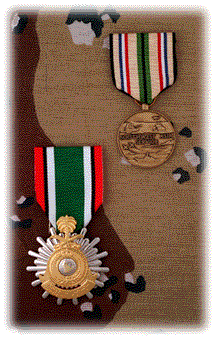Southwest Asia Service Medal
The Southwest Asia Service Medal (at right in photo) was established 12 March 1991 by Executive Order 12754 from President George Bush.
The medal is awarded to any member of the armed forces for service in prescribed geographical parts of the Middle East during Operations Desert Shield and Desert Storm.
The wearing of as many as three service stars on the suspension ribbon and ribbon bar currently is authorized, one for the period from 02 Aug. 1990 to 16 Jan. 1991, a second one for the period 17 Jan.-11 April 1992 and a third one for the period beginning 12 April 1992 and closing 30 Nov. 1995.
Members of the Armed Forces of the United States serving in Israel, Egypt, Turkey, Syria and Jordan (including the airspace and territorial waters) between 17 January 1991 and 11 April 1991, will also be eligible for this award. Members serving in these countries must have been under the command and control of U.S. Central Command or directly supporting military operations in the combat theater.
The front of the medal, which was designed by the Army Institute of Heraldry, reflects the roles of each of the services with images of tanks, ships and aircraft. The ribbon's dominant color is that of desert sand with other colors alluding to the American red, white and blue and colors representative of allied armed forces.
Most sailors and Marines participating in Operations Desert Shield and Desert Storm were presented the Liberation of Kuwait Medal (at left in photo) by King Fahd Bin Abdul Aziz of Saudi Arabia.
It was awarded to those who served or flew into the war zone between Jan. 1, 1991, -- the start of the air war -- and Feb. 28, 1991, when offensive operations concluded.
The war zone included Iraq, Kuwait, Saudi Arabia, Oman, Bahrain, Qatar and the United Arab Emirates.
At sea, the war zone is defined as the Persian Gulf, Red Sea, Gulf of Oman, Gulf of Aden and portions of the Arabian Sea.
Basically, service members qualified if they were attached to units participating in ground or shore operations, aboard ships directly supporting military operations, or participating as crew members in aerial missions directly supporting military operations within the war zone.
Service members received the medal at no cost, but the logistics of manufacturing and distributing nearly 500,000 medals meant some delays.
The medal is suspended from a green ribbon with red, black and white stripes, representing flags of Saudi Arabia and Kuwait. The medal depicts a Royal Palm with crossed sabers - emblems of Saudi Arabia - superimposed on a sunburst, symbolizing the light of freedom "which once again shines over Kuwait." Inside the sun emblem is a globe featuring the Arabian Peninsula.
A listing of eligible periods of service is found in the Navy Battle Streamer section.
21 June 1998



